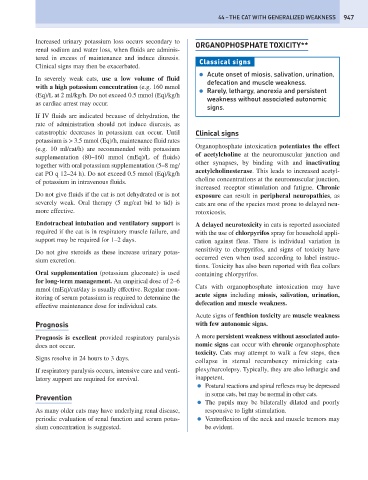Page 955 - Problem-Based Feline Medicine
P. 955
44 – THE CAT WITH GENERALIZED WEAKNESS 947
Increased urinary potassium loss occurs secondary to
ORGANOPHOSPHATE TOXICITY**
renal sodium and water loss, when fluids are adminis-
tered in excess of maintenance and induce diuresis.
Classical signs
Clinical signs may then be exacerbated.
● Acute onset of miosis, salivation, urination,
In severely weak cats, use a low volume of fluid
defecation and muscle weakness.
with a high potassium concentration (e.g. 160 mmol
● Rarely, lethargy, anorexia and persistent
(Eq)/L at 2 ml/kg/h. Do not exceed 0.5 mmol (Eq)/kg/h
weakness without associated autonomic
as cardiac arrest may occur.
signs.
If IV fluids are indicated because of dehydration, the
rate of administration should not induce diuresis, as
catastrophic decreases in potassium can occur. Until Clinical signs
potassium is > 3.5 mmol (Eq)/h, maintenance fluid rates
Organophosphate intoxication potentiates the effect
(e.g. 10 ml/cat/h) are recommended with potassium
of acetylcholine at the neuromuscular junction and
supplementation (80–160 mmol (mEq)/L of fluids)
other synapses, by binding with and inactivating
together with oral potassium supplementation (5–8 mg/
acetylcholinesterase. This leads to increased acetyl-
cat PO q 12–24 h). Do not exceed 0.5 mmol (Eq)/kg/h
choline concentrations at the neuromuscular junction,
of potassium in intravenous fluids.
increased receptor stimulation and fatigue. Chronic
Do not give fluids if the cat is not dehydrated or is not exposure can result in peripheral neuropathies, as
severely weak. Oral therapy (5 mg/cat bid to tid) is cats are one of the species most prone to delayed neu-
more effective. rotoxicosis.
Endotracheal intubation and ventilatory support is A delayed neurotoxicity in cats is reported associated
required if the cat is in respiratory muscle failure, and with the use of chlorpyrifos spray for household appli-
support may be required for 1–2 days. cation against fleas. There is individual variation in
sensitivity to chorpyrifos, and signs of toxicity have
Do not give steroids as these increase urinary potas-
occurred even when used according to label instruc-
sium excretion.
tions. Toxicity has also been reported with flea collars
Oral supplementation (potassium gluconate) is used containing chlorpyrifos.
for long-term management. An empirical dose of 2–6
Cats with organophosphate intoxication may have
mmol (mEq)/cat/day is usually effective. Regular mon-
acute signs including miosis, salivation, urination,
itoring of serum potassium is required to determine the
defecation and muscle weakness.
effective maintenance dose for individual cats.
Acute signs of fenthion toxicity are muscle weakness
Prognosis with few autonomic signs.
Prognosis is excellent provided respiratory paralysis A more persistent weakness without associated auto-
does not occur. nomic signs can occur with chronic organophosphate
toxicity. Cats may attempt to walk a few steps, then
Signs resolve in 24 hours to 3 days.
collapse in sternal recumbency mimicking cata-
If respiratory paralysis occurs, intensive care and venti- plexy/narcolepsy. Typically, they are also lethargic and
latory support are required for survival. inappetent.
● Postural reactions and spinal reflexes may be depressed
in some cats, but may be normal in other cats.
Prevention
● The pupils may be bilaterally dilated and poorly
As many older cats may have underlying renal disease, responsive to light stimulation.
periodic evaluation of renal function and serum potas- ● Ventroflexion of the neck and muscle tremors may
sium concentration is suggested. be evident.

